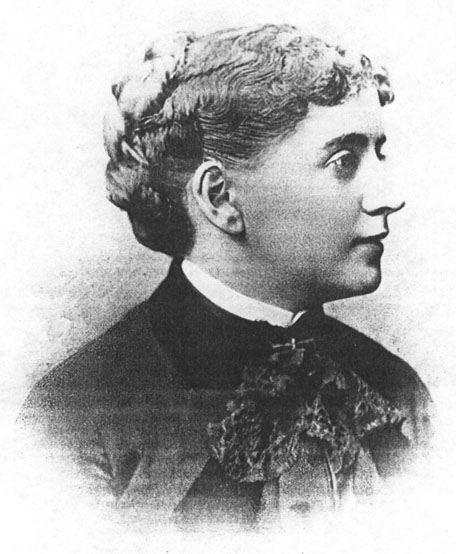Conner Habib’s series The Sex Radicals will be appearing regularly this summer on Reality Sandwich.
“If you believe in Jesus, aspire to be in unison with His will from the moment the [sexual] ecstasy sets in…” – Ida Craddock (1857-1902), mystic, women’s rights advocate, and sex radical.
In 1893, Chicago was humming with an urgent darkness; it was a year of blood. The Mayor was assassinated by an angry and envious political hopeful. A serial killer, H.H. Holmes was stalking the streets of the city, claiming dozens of victims. And Columbus’s brutal arrival in the Americas was being commemorated by The World’s Fair. To stand at the edge of the Fair was to look from a dark room into light. Enter the Fair, and you could leave Chicago, even though you were still in it. There were representations of buildings and cities from around the world to inspire architects and planners. The World’s Parliament of Religions, with representatives from Buddhism, Confucianism, Hinduism, Jainism, Shintoism and more, shocked a new world-awareness into patrons.
The Fair’s Middle Eastern replica, “Cairo Street,” boasted what would seem like an embarrassment of orientalist romanticization today. But in the late 19th Century, the exhibit was alluring, a shiver of power. There was Middle Eastern architecture, the twisting strums of Arabic music playing, people smiling on top of camels.
And there were belly dancers.
In the Egyptian Theatre, women with exposed midriffs made waves of their bodies, turning and flowing to the music. Their arms gracefully ascended into the air then snaked their way back, closer to their bodies. The performances were a huge hit, drawing crowds and exaggerated news coverage. They also drew detractors, who, in a blended condemnation of Arab cultures and sexual expression, proclaimed the shows “demoralizing and disgusting.”
Anthony Comstock was among them, leading the public outcry. Comstock was head of the state-sponsored New York Society for the Suppression of Vice. The globe of his bald head was held by a ring of facial hair that drooped from his cheeks like the slavering jowls of a St. Bernard. He was fond of bow ties. He was a serious person with a serious mission: destroy obscenity. The Society’s badge bore a proud picture of a man dropping books in a fire on one side and a baton-wielding police officer pushing some obscene chap into a cell by his neck. That would do it! These pagan belly dancers — savages! — would have to go into the fire along with all those books.
But while Comstock was raising protests, a defense appeared in the the newsprint pages of New York World. Instead of the dancing being the hip-thrusting of primitives, the defense read, it was a valuable tool in understanding sex, how to move during sex with your partner, the sacredness of sexuality. The defense was outrageous and pulsed with the newness of the Fair. In a time of blood and death, it was a rebirth. The author was Ida Craddock, a women’s rights advocate, stenography teacher, and spouse of an angel. Her mission, also serious, was nothing less than the reinstatement of sex to sacred stature. The world was changing. The moment to rethink sex was at hand.
Craddock was born in Philadelphia in 1857, and endured a puritanical childhood with a paranoid mother who would continue throughout life to be one of her staunchest enemies. Wherever Craddock walked, she encountered patriarchal and sex-phobic ideals forcefully gripping the culture She spent her time systematically prying the fingers back, sometimes successfully. When she was in her twenties, she clashed with the University of Pennsylvania, who refused to admit women into their liberal arts school. Later, frustrated with the limits of Protestantism, she became a Unitarian and called for “Free Thought” Sunday schools, where children would be taught all religious traditions, rather than just one.
Like many radicals of the time, Craddock found freedom in spiritualism. Today, the occult and spirituality are often ridiculed by the Left, but they played a vital part in the formation of Leftist, feminist, and radical politics, not to mention social justice movements. For instance, Craddock’s eye was always on the oppression of women. Since religion was a key in oppressing women, many activists — including the first female presidential candidate, Victoria Woodhull — worked to create new models of religion to replace what was thought to be the phallocentric Christian one, in which the cross itself was seen as an oppressive phallic symbol. Craddock started out as a skeptic, even a debunker. But eventually, the currents of liberatory spiritualism made their way into her thinking, and she began to seek correspondence with the imagined and real world of spiritual entities. One of them was a seventeen year-old boy she’d known when she was younger. He was killed in an accident and now appeared to her as an angel named Soph. Why not marry an angel? After some loving correspondence with Soph, Craddock did, and reported her ecstatic sexual experiences with him in a language that strongly resembles the language of objectum sexuals, who fall in love with and make love to objects and landmarks. It’s a moving language of ecstasy – an encounter with a partner whose being-ness others can’t understand. The invisible breath of the angel so in love with you, that you’re the only one who can see him.
From her scholarly work, her relationship with Soph, her experience in activism, and her encounters with feminist allies, Ida Craddock enacted her strategy to empower people, particularly women. She started to educate — in-person and through pamphlets — women about their bodies so that they could experience intense sexual pleasure in their relationships rather than live in the dull un-erotic circumstances they’d found themselves in. Craddock’s message was that women had as much of a right to sexual pleasure as their husbands, and that this pleasure was a sacred right. Sex was a gift from God. Sexual pleasure was part of Jesus Christ’s message. Any other interpretation of religion was the love of God passed through a distorted lens. Craddock hoped that this religious foundation of sexual pleasure would create a door for the devout and sexually timid. And she also hoped it would protect her, via the Bill of Rights, from censorship.
But while Craddock had her hopes, Comstock had his very own Act. The Comstock Obscenity Act prevented any obscene information and material from being sent through the US mail. Obscene, as usual, was defined broadly enough to mean anything, including contraceptives, abortion info, sexual instruction, and more. Craddock’s advice was, indeed, explicit for the time – “perform the pelvic movements during the embrace, riding your husband’s organ gently,” she’d written in her publication, The Wedding Night, “up, down, sideways with a semi-rotary movement.” Her pamphlets were thwarted at every turn, forced into obscurity shortly after they hit the postal service. But as a “sexologist” (her self-chosen title) it was harder to stifle her message, since she offered in-person consultations with people in sexual need.
Craddock’s message: If sex and pleasure do not fit into your model of culture, well, then, redraw your model to make room for them. Like the Fair, the contours of your relationship with your partner and God were containers for sights unseen, new experiences, new ways to experience the world and yourself and be free.
Since our attitudes toward sex have been so distorted by people and institutions in power, all sexual revolutionaries of all eras absorb the prejudices and sexual shaming of their time. A lot was lost in Craddock’s religion-meets-sex approach. Even though she was well-versed in the religious history of sexual rituals and wanted women to be liberated from “sex slavery” (a term of her time that loosely approximates to patriarchy), she was so focused on religion that she often lost sight of sex. This is evident in her moral admonitions of oral sex, prostitution and more.
These limits in her thinking show up as sadness and confusion. In two separate cases, men, both interested in sex and love with other men, approached her. She wavered in a perplexed position. Would she find herself in strange alliance with Comstock’s laws, which prohibited depictions of or information about homosexual behavior (and would do so until 1958)? She struggled with whether or not this could be love and not just perversion. That she struggled at all was due in part to the influence of another sexual reformer of the time, Walt Whitman’s protege, Edward Carpenter. Carpenter wore black ties, had sharp features, enjoyed sex with other men, and corresponded with Gandhi. Craddock admired his brilliant and powerful writings about the collapse of civilization and the tenderness of love between men.
But Craddock was unable to undo all the currents of traditional repression. She managed on the one hand to be radical and on the other to be traditional; her focus didn’t stray far from heterosexual monogamy. But what she said you could do within a monogamous partnership was revolutionary. It was inspiring even the most radical thinkers. “Her learning is enormous,” wrote magus Aleister Crowley, in a review of Craddock’s Heavenly Bridegrooms, which he called, “one of the most remarkable human documents ever produced.”
Life as a radical can be lonely and beleaguered, even with an angel at your side. Craddock’s own mother conspired with authorities to have her admitted to a mental institution. The federal government seized her work. She was considered a witch, no small burden to bear at the time. For Comstock, her mother, and the judges at her various trials, it didn’t matter that Craddock’s message was intertwined with Christ. Her embrace of sexual pleasure meant that her angelic husband might as well have been a the devil whispering into her ear.
In 1902, she was sentenced to three months in prison. If she would admit she were insane, she knew, she could avoid prison time. But Craddock refused. When you have seen into the contracted heart of the world’s insanity, what can you do but plead you are sane?
She was released amongst cries of public support and then immediately arrested again, under the Comstock law. Comstock would not stop attacking Ida Craddock. Like the anti-prostitution and anti-porn bigots of today, who delight in attacking sex workers, this was where he found his pleasure.
Unwilling to be Comstock’s partner in pleasure any longer, Craddock went home, turned on the oven gas, and slit her wrists.
She left two letters. One was an open letter, condemning Comstock and the country’s sexual state of affairs. It was a plea to understand the damage being done to our world by obscenity laws, dead marriages, the oppression of women, sexual ignorance.
The second letter was to her mother, but its sentiments also ripple out into the waters of history, hoping to find all of us.
“I love you, dear mother; never forget that. And love cannot die; it is no dream, it is a reality.” Some day, she wrote, her work would be taken up by others and her mother would not be ashamed.
“Some day,” she wrote, “you’ll be proud of me.”
Western culture is still learning this lesson: that we have a right, a sacred right (whether we’re religious or not) to sexual pleasure. And if our worldview or our relationship doesn’t allow for it, we must recreate their boundaries.
Ida Craddock lay in her apartment, sealed off with these letters. There, she bled and breathed false air until she died.
Next up: Sex is Liberation: Paschal Beverley Randolph’s Divine Sexual Freedom
Sources
Chappell, Vere. Sexual Outlaw, Erotic Mystic: The Essential Ida Craddock.
San Francisco: Weiser, 2010.
Schmidt, Leigh E. Heaven’s Bride: The Unprintable Life of Ida C. Craddock, American
Mystic, Scholar, Sexologist, Martyr, and Madwoman. New York: Basic, 2010.
IdaCraddock.com














